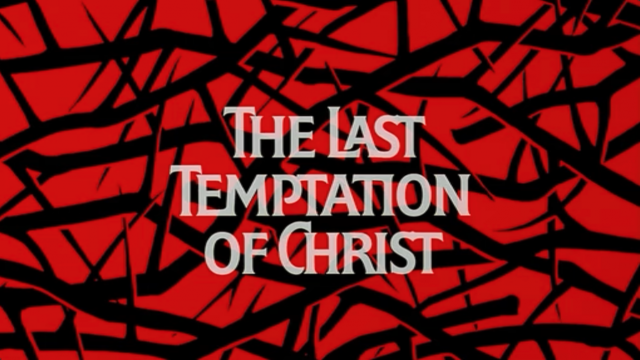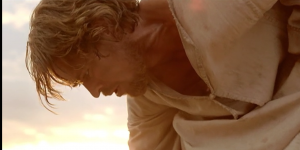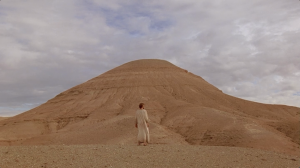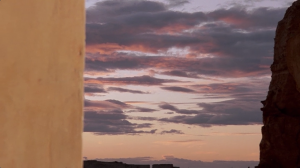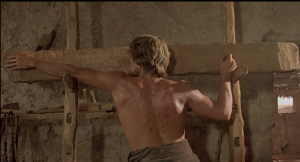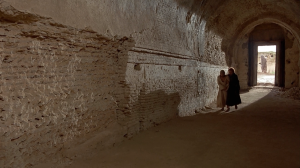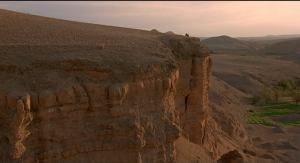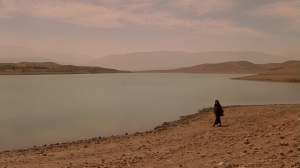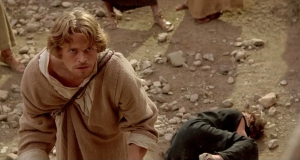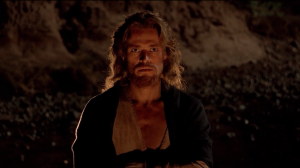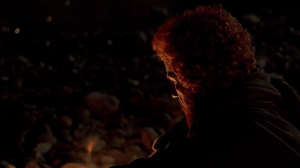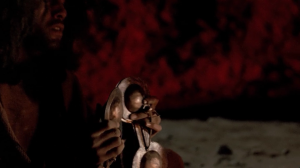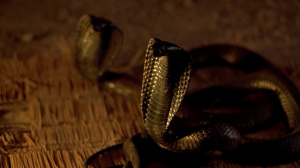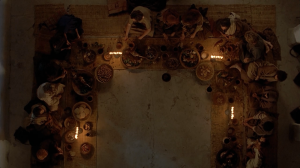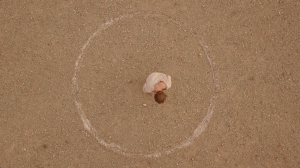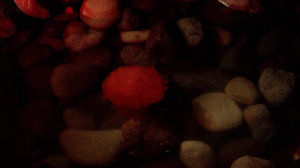My image of God needs breaking from time to time. He breaks it Himself. He is the great iconoclast – C.S. Lewis
Scorsese had spent the last decade of his career trying to get this one movie made. He ran through the worst Hollywood has to offer – censorship, death threats, funding offered only to be pulled again, and again, and again. As far as I can see, every bit of sacrifice was worth it, to create what might be the greatest film ever made about the great Sacrifice, a perfect, flawed, blasphemous, faithful masterpiece. I’m not sure if I love it, but I know I’m obsessed with it. Two articles, adding up to somewhere around eight or nine pages (single spaced!) might seem excessive, but it’s barely enough space to say all there is to say about this film. Like the works of Christ Himself, if I said everything there is to say about The Last Temptation, “I suppose that even the world itself could not contain the books that should be written.”
It opens with the thrumming, percussive beat of Peter Gabriel’s score, and a pan over the cover of Nikos Kazantzakis’ book. We find Jesus the way we’re used to seeing Him, in a peaceful green landscape. But then He wakes up and He is in His workshop, making crosses. This is not the way we’re used to seeing Jesus at all, and this point, I began to think maybe this film was the sacrilegious spit in the face it was so often characterized as. This Jesus doesn’t just make torture implements for the enemies of the Jews – He does it because He wants God to hate Him.
The central biblical passage for this film is from St. Paul: “He was tempted like us in all ways, yet without sin.” Last Temptation shows, more than any work of art I’ve ever seen, what it really means for Jesus to be tempted like us in all ways. But how can this Jesus really be without sin? As always, Scorsese is generous: “He’s made to feel like He’s sinning – but He’s not sinning, He’s just human.” But that’s the kind of humanity that’s incompatible with divinity. You could argue that to hate God is actually the worst possible sin. And can anyone really be as tormented by guilt as Jesus is here without deserving it? Least of all, an omniscient being, which is what the Biblical Jesus is, predicting His death to the apostles every step of the way instead of having it sprung on Him at the last minute.
I’ll try to be brief with this aspect of the film: in his great Great Movies essay on Last Temptation, Roger Ebert admitted he was embarrassed by his previous review, saying, “It must have driven Scorsese crazy to read many similar reviews in which critics appointed themselve sarbiters of the manhood or godliness of Jesus Christ, and scarcely mentioned the direction, the writing, the acting, the images or Peter Gabriels’s harsh, mournful music.” Theology is important – more important than art, to my mind – but it’s not what this column is about. The Last Temptation is not a literal adaptation of the Bible, and if it were, it’s no less faithful than many others. Previous lives of Christ had been so concerned with blasphemy that their scripts were shopped around to hundreds of priests of every denomination for approval. But in dancing around doctrinal issues, these films were unable to say anything we don’t already know. In this case, all things to everybody is quite nearly nothing to anybody. Scorsese could hardly care less about getting church authorities angry. And maybe what angered them was not so much the deviation from the scriptures as how uncomfortably close the film brought them.
But The Last Temptation of Christ is a work of heresy, make no mistake. It is also one of the most Christian things ever put on film. The Gospels are full of paradoxes, so why shouldn’t the adaptation be one itself? Like Travis Bickle, it’s partly truth and partly fiction, a walking contradiction. The heretical fiction in this film only strengthens the biblical truth, or at the very least, it’s the price we pay for it. Paul Schrader, who wrote this film after partnering with Scorsese on two of his most deeply spiritual movies, Taxi Driver and Raging Bull, says it best:
“The two major heresies which emerged in the early Christian Church were the Arian heresy, from Arius, which essentially said that Jesus was a man who pretended to be God; and the other was the Docetan heresy, which said that Jesus was really God, who, like a very clever actor, pretended to be a man. So they called a council and branded both philosophies as heresy; but in fact the Church has tended anyway to go on its merry Docetan way…The Last Temptation may err on the side of Arianism, but it does little to counteract the 2000 years of erring on the other side, and it was pleasant to see this debate from the early Church splashed all over the front pages.”
So the film allows us to see Jesus as a real human being, who can feel pain and sorrow, who truly struggled with temptation instead of being able to shrug it off, who drank wine with sinners and honestly did want to turn back in Gethsemane. Last Temptation makes Jesus dangerous again, a revolutionary Madman, whose messages of love and the ax are both too extreme for us, and somehow neither contradict nor compromise each other – and there’s another Gospel paradox. Maybe that’s what scared the censors so much. They were used to a Jesus who looked down from heaven and nodded at what they might want to do anyway.
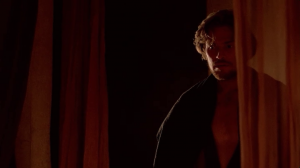
This Jesus is fully human, and it would seem Scorsese defines humanity as separation from God, all the more painful when He is God at the same time as He is His tormented mortal instrument. I don’t know if any of Scorsese’s critics actually accused him of this, but it’s possible to see the film as a kind of auto-idolatry, when so many of the changes from the dogma bring Jesus closer to the director himself. He’s tormented by guilt and sexual hang-ups, constantly struggling with doubt and unable to reach God – in other words, a lot like Scorsese. Marty of Nazareth. That could be a flaw or a strength: after all, if this a parable rather than a literal exploration of Jesus’ life, this humanized version is a powerful metaphor for the human condition. The film interprets Jesus’ nature as fully human and fully divine as something much like all of us, half-carnal and half-spiritual, with each warring against the other.
Willem Dafoe might not be anyone but Scorsese’s choice for Jesus (he also considered Christopher Walken and Eric Roberts, which would have made A Talking Cat??? even more disturbing). But he’s perfect, especially in all the ways he’s unsuited for the part. I’m mostly familiar with him from roles in movies like The Grand Budapest Hotel and Spider-Man, but that menace is perfect here. It makes it easy to believe that this Jesus wants to burn the world to the ground and replace it with the “world of God.” When I first saw this a year ago, I had just read a Flannery O’Connor story called “Parker’s Back.” Parker asks for a tattoo of Jesus’ face on his back, and, disappointed by dewy-eyed modern Christs, flips to the back of the artist’s book and settles on an intense Greek icon, of the kind Scorsese has hanging in his house. When Jesus appears at the disciples’ campfire after being tempted in the wilderness, my first thought was, that is the face on Parker’s back.
Dafoe’s imposing presence doesn’t mean he has an imposing body type, though. It’s often been pointed out that, as a carpenter, Jesus would have been a big guy. Dafoe is far more androgynous, giving a performance that makes Jesus even more universal. He has a frailty that makes his Jesus’ torments more painful to watch, and his gaunt face easily transitions from warm to terrified to terrifying. He paints a picture of what Scorsese calls, “something I could relate to: this was a Jesus you could sit down with, have dinner or a drink with.” There are shades of Max Von Sydow as Antonius Block in The Seventh Seal here, a Man whose deep sensitivity and private pain only strengthen His love for those around Him. And Harvey Keitel as Judas plays the the role of Jons the squire, the world-weary cynic, who is nevertheless faithful to his friend whose thoughts are on the next world.
Jesus’ world also shatters the expected formula. The idea had begun as a documentary-style retelling of the Gospels in New York City (where else?), and that intent is still present here. Harvey Keitel’s Brooklynese Judas netted him a Worst Actor nomination at the Golden Raspberries, but it’s at least as deserving of a “Best” nod. These people can’t talk like they do in The Ten Commandments or The Greatest Story Ever Told. Scorsese sees them as real, ordinary people, using real, ordinary language. Even the Roman soldier reading the charges against a man crucified on one of Jesus’ crosses does it with more boredom than gravitas. The American accent is one more step in tearing down the layers of distance audiences have from biblical narrative. This urban version of the apostles emphasizes their relatability, and maybe their Jewishness as well – after all, the Jews we know from media and from life sound more like Mel Brooks than Charlton Heston. Scorsese, Schrader, and Jay Cocks make the words of the Bible seem both less over-familiar, and more familiar to our everyday experience of speech. Viewers are used to Jesus poetically saying the rocks will cry out for Him. But it’s an entirely different experience to hear Him shouting, wild-eyed, “If I could touch every stone, if I could breathe on every branch, they’d get up and follow me. So what’s wrong with you?”
And Scorsese puts these realistic, familiar characters in a realistic, foreign world. He was reading Biblical Archaeology religiously on the set, and it shows. Whether it’s accurate or not, it feels accurate, because the details are so specific and so strange, like the pearly blocks the spirit of Isaiah wears on his fingers, or the women on camels wearing hoods that cover their whole bodies. This may be the most authentically Middle Eastern Bible film ever made, even with a mostly white American cast working in North Africa. Besides the evocative Moroccan locations, there’s the exotic jewelry, the intricate Henna-ish tattoos, the loving recreation of two-thousand-year-old rituals. The location shooting has the same lived-in feel as the more recent past of Boxcar Bertha, but with an even greater sense of time and place. These are real people in a real place, and the fact that those two realities are separated by thousands of years gives the film a tension that sometimes leads to unwanted laughter, but more often to the most concrete possible version of the story.
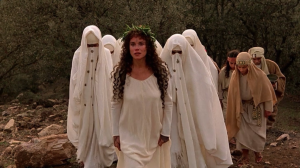
The threat of the furtive laugh is the film’s only major flaw, from Harry Dean Stanton as St. Paul pronouncing the word “muuurderrred” like Fozzie Bear, or the discovery that Willem Dafoe ages into Steve Buscemi. Scorsese was aware of the risk, and at times he embraced it. “Judas’ line in the movie gets a great laugh: ‘The other day you said, ‘A man slaps you, you turn the other cheek.’ I don’t like that!’ Who does!? I agree with you Judas, how do you do it?” He also includes some subtle jokes about Lazarus being “slow” after coming back from the dead – in fact, the character appears more as a zombie than a fully resurrected man. That shows a certain lack of faith in the power of Jesus’ miracles, but the film is a whole may be the most truly miraculous of the filmed lives of Christ, and it does this by blending many different methods of portraying the miracles. Some seem entirely natural, like when he adds the detail of Judas giving Jesus some herbs to rub on His hands before spitting in the blind man’s eyes. Some are wonderfully matter-of-fact, like when Jesus gets in an argument during the wedding at Cana at whether the jars are full of water or wine, with the actual transformation occurring offscreen.
But most of the miracles are full of a primitive, almost pagan spirituality. Kazantzakis, like his version of Jesus, had spent time in a monastery, and whatever mystic experience he may have had there carries through to his book, and to Scorsese’s film. The supernatural in the film is extremely physical, most shockingly when Schrader interprets the Catholic iconography of the Sacred Heart as Jesus literally reaching inside His chest and pulling out His bloody, beating heart. Michael Ballhaus follows it up with a beautiful shot of the blood dripping into the lake, making strange lavalamp shapes under the water. The Protestant screenwriter contributed an equally powerful literalization of Catholic doctrine for Scorsese at the Last Supper. All the mystery and power of the Holy Eucharist is there. So too is the doctrine of transubstantiation, when Peter curiously sticks his finger in his mouth and pulls out not wine, but dark blood. Ghosts appear to give Jesus His directives from God, and Satan appears to Him in the wilderness as symbolic figures of the World, the Flesh, and the Devil.
The Last Temptation is full of this kind of mysterious spirituality, all embedded in the physical world, of visions that are solid and very literally present, of the imagery of body and blood. “There’s so much attention to bodies here,” our own Wallflower writes, “Magdalene’s sweat, Jesus’ blood, Lazarus’ decay, John the Baptist’s hair, the dirt on the clothes of the Apostles, the blood of animals, and I will never get tired of watching Harvey Keitel’s Judas scratching his beard.” That’s the primitive physicality of the film, hearkening back to That Old Time Religion, the kind that hasn’t been intellectualized and spiritualized, but exists in the raw, real world, but still full of supernatural mystery. There are explicit allusions to those influences too: before He is crucified, Jesus receives the stigmata like a medieval monk, the presence of God in His flesh gives Him seizures like a Holy Roller, and He draws a mystic circle of protection of the kind used in pre-Christian and counter-Christian ritual. And then there’s Andre Gregory as John the Baptist, a truly mad prophet, a counterculture figure who leads crowds of self-flagellating penitents and nude dancers, whipped into a frenzy of spiritual ecstasy.
Ritual itself is hugely important here. The priest’s-eye-view from Taxi Driver makes a return, this time showing not a perversion of the Eucharist on the altar, but the original that the Church is imitating. There are constant slice-of-life snippets of Jewish ritual, goats being cut up and blood running down the Temple drain, foreshadowing Jesus’ death and the nature of it. He is the ritual sacrifice to reunite God and man, much more than any enlightened spiritual ideas of love and self-denial. Actually, it’s a surprise how much the fundamentalists rejected this film, since it seems to be part of that tradition to its core, the snake-handling side in particular. And those ultra-conservative Christians may have embraced it more than the media gave them credit for: in Scorsese on Scorsese, the director repeats a story from Jay Cocks, of a screening with two “black ladies behind him saying, ‘Hallelujah!’ and ‘That’s the way He said it!’… Which is exactly the way it should be.” The Jesus of the film is certainly a fire and brimstone preacher, confronting everyone He meets with their unworthiness, daring them to repent, to love Him or crucify Him. When He returns from His meditation in the desert with the ax he used to fell the Tree of Knowledge, He says, “Once I believed in love. Now I believe in this!” But the genius of the movie is how much those two opposing forces are one and the same.

